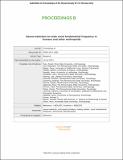Files in this item
Sexual selection on male vocal fundamental frequency in humans and other anthropoids
Item metadata
| dc.contributor.author | Puts, David A. | |
| dc.contributor.author | Hill, Alexander K. | |
| dc.contributor.author | Bailey, Drew H. | |
| dc.contributor.author | Walker, Robert S. | |
| dc.contributor.author | Rendall, Drew | |
| dc.contributor.author | Wheatley, John R. | |
| dc.contributor.author | Welling, Lisa L.M. | |
| dc.contributor.author | Dawood, Khytam | |
| dc.contributor.author | Cárdenas, Rodrigo | |
| dc.contributor.author | Burriss, Robert P. | |
| dc.contributor.author | Jablonski, Nina G. | |
| dc.contributor.author | Shriver, Mark D. | |
| dc.contributor.author | Weiss, Daniel | |
| dc.contributor.author | Lameira, Adriano R. | |
| dc.contributor.author | Apicella, Coren L. | |
| dc.contributor.author | Owren, Michael J. | |
| dc.contributor.author | Barelli, Claudia | |
| dc.contributor.author | Glenn, Mary E. | |
| dc.contributor.author | Ramos-Fernandez, Gabriel | |
| dc.date.accessioned | 2018-01-11T14:30:07Z | |
| dc.date.available | 2018-01-11T14:30:07Z | |
| dc.date.issued | 2016-04-27 | |
| dc.identifier | 252018308 | |
| dc.identifier | fcc84919-f214-46ed-b678-1d59ebd7f01e | |
| dc.identifier | 84964734909 | |
| dc.identifier | 27122553 | |
| dc.identifier.citation | Puts , D A , Hill , A K , Bailey , D H , Walker , R S , Rendall , D , Wheatley , J R , Welling , L L M , Dawood , K , Cárdenas , R , Burriss , R P , Jablonski , N G , Shriver , M D , Weiss , D , Lameira , A R , Apicella , C L , Owren , M J , Barelli , C , Glenn , M E & Ramos-Fernandez , G 2016 , ' Sexual selection on male vocal fundamental frequency in humans and other anthropoids ' , Proceedings of the Royal Society B: Biological Sciences , vol. 283 , no. 1829 , 2830 . https://doi.org/10.1098/rspb.2015.2830 | en |
| dc.identifier.issn | 0962-8452 | |
| dc.identifier.uri | https://hdl.handle.net/10023/12466 | |
| dc.description | D.A.P. was supported by a National Institutes of Mental Health T32 MH70343-05 fellowship. J.R.W. was supported by a National Science Foundation predoctoral fellowship. | en |
| dc.description.abstract | In many primates, including humans, the vocalizations of males and females differ dramatically, with male vocalizations and vocal anatomy often seeming to exaggerate apparent body size. These traits may be favoured by sexual selection because low-frequency male vocalizations intimidate rivals and/or attract females, but this hypothesis has not been systematically tested across primates, nor is it clear why competitors and potential mates should attend to vocalization frequencies. Here we show across anthropoids that sexual dimorphism in fundamental frequency (F0) increased during evolutionary transitions towards polygyny, and decreased during transitions towards monogamy. Surprisingly, humans exhibit greater F0 sexual dimorphism than any other ape. We also show that low-F0 vocalizations predict perceptions of men’s dominance and attractiveness, and predict hormone profiles (low cortisol and high testosterone) related to immune function. These results suggest that low male F0 signals condition to competitors and mates, and evolved in male anthropoids in response to the intensity of mating competition. | |
| dc.format.extent | 808538 | |
| dc.language.iso | eng | |
| dc.relation.ispartof | Proceedings of the Royal Society B: Biological Sciences | en |
| dc.subject | Anthropoid primates | en |
| dc.subject | Attractiveness | en |
| dc.subject | Dominance | en |
| dc.subject | Mating system | en |
| dc.subject | Sexual selection | en |
| dc.subject | Vocal fundamental frequency | en |
| dc.subject | QH301 Biology | en |
| dc.subject | BF Psychology | en |
| dc.subject | Biochemistry, Genetics and Molecular Biology(all) | en |
| dc.subject | Immunology and Microbiology(all) | en |
| dc.subject | Environmental Science(all) | en |
| dc.subject | Agricultural and Biological Sciences(all) | en |
| dc.subject | DAS | en |
| dc.subject.lcc | QH301 | en |
| dc.subject.lcc | BF | en |
| dc.title | Sexual selection on male vocal fundamental frequency in humans and other anthropoids | en |
| dc.type | Journal article | en |
| dc.contributor.institution | University of St Andrews. School of Psychology and Neuroscience | en |
| dc.contributor.institution | University of St Andrews. Centre for Social Learning & Cognitive Evolution | en |
| dc.identifier.doi | 10.1098/rspb.2015.2830 | |
| dc.description.status | Peer reviewed | en |
| dc.identifier.url | http://dro.dur.ac.uk/18829/ | en |
This item appears in the following Collection(s)
Items in the St Andrews Research Repository are protected by copyright, with all rights reserved, unless otherwise indicated.

